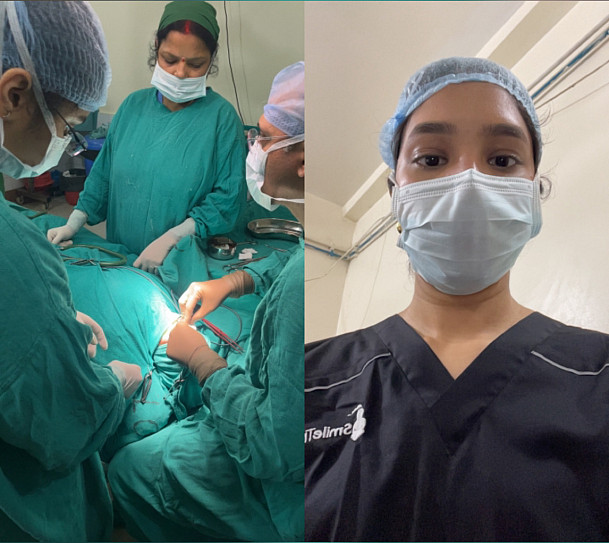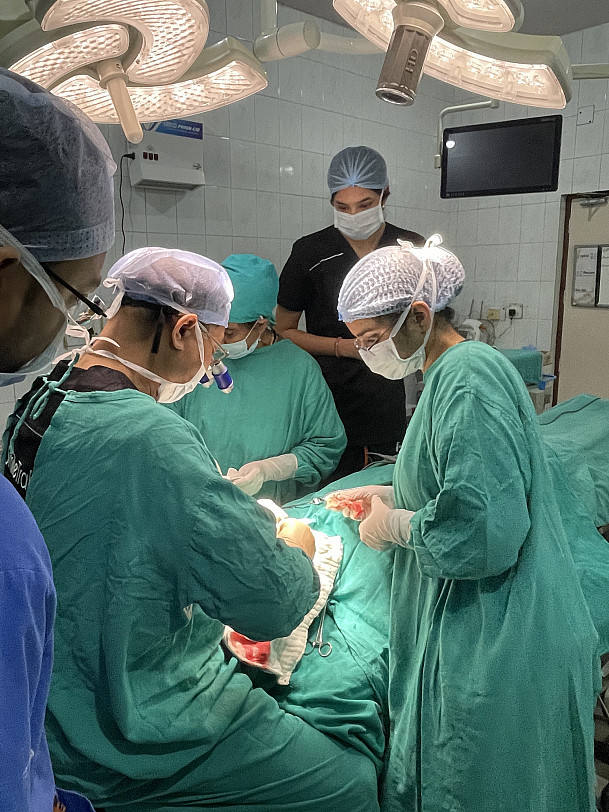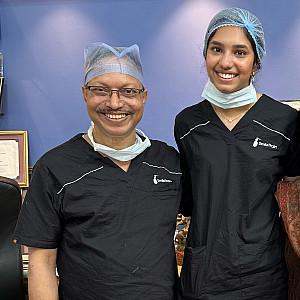Ten dollars. The cost of a Starbucks drink, a Crumbl cookie, or the tip we leave after dinner without thinking twice. But in Varanasi, $10 is the price of a life-changing surgery. At G.S. Memorial Hospital, $10 is all it takes to repair a cleft lip or palate—a condition that can make something as simple as eating or speaking an impossible challenge. For many families, though, even $10 is more than they could ever afford.
I spent a week at G.S. Memorial Hospital during my 2024–25 winter break, working alongside doctors and medical fellows as part of my research project on the socioeconomic factors behind cleft conditions. A cleft lip or palate occurs when the upper lip or roof of the mouth doesn’t fully develop in the womb, leaving a gap that affects everything from nutrition to speech. The condition can be corrected with surgery, but it often takes multiple procedures over several years. While clefts occur due to genetic factors, their connection to poverty is undeniable—something I witnessed firsthand as I met patients and families from across India, many of whom had spent years trying to reach this clinic in the hopes of a better future.
Even though I lived in India for the first 11 years of my life, nothing quite prepared me for Varanasi. The city is over 3,000 years old, making it one of the oldest continuously inhabited places in the world. It is the spiritual heart of India, where millions of people come each year to bathe in the Ganges or spend their final days believing that dying here leads to Moksha—liberation from the cycle of rebirth. But beyond its ancient ghats and temples, I saw an entirely different reality. Thousands of people are living in unimaginable poverty, struggling for basic necessities like food, clean water, or shelter. The contrast was striking: a city so deeply rooted in faith and spiritual freedom, yet filled with people trapped by their circumstances, unable to escape the weight of daily survival.

At the heart of this paradox is G.S. Memorial Hospital, where world-renowned surgeon Dr. Subodh Kumar and his team perform thousands of cleft surgeries every year, offering life-changing procedures at little to no cost. Dr. Kumar has completed over 8,000 surgeries—more than 20 every week. To put that into perspective, most surgeons might perform a few hundred in their lifetime. Yet, despite his record-breaking achievements, he remains grounded in a mission that isn’t about numbers but about people. Beyond cleft surgeries, he has also committed to treating burn victims and is currently building a new hospital wing specifically for them, investing both his own money and fundraising to provide care for those who need it most.
From the moment I walked into the hospital, I was thrown straight into the action. The team quickly handed me a set of scrubs and ushered me into the operating room. They warned me that I might feel faint at the sight of surgery—that the blood and precision of the procedure could be overwhelming—but instead, I found myself in awe. The child on the table was so small, so fragile, yet within a matter of hours, her entire future would be rewritten.
Throughout the week, I met an extraordinary group of people who had dedicated their lives to this work. Many of the hospital’s fellows—young women who left behind careers in major cities like Delhi and Mumbai—chose to work under Dr. Kumar, not because it was easy, but because they believed in what they were doing. They shared stories of long shifts, challenging cases, and the struggles of working in a small clinic with limited resources, but their passion never wavered. Watching them, I saw what true commitment looked like—not just to medicine, but to the people they served.
One of the most unforgettable patients I met was a 5-year-old girl named Meena. Born with a cleft lip, she had struggled to eat and was often teased by the other children in her village. Her mother had spent years saving every rupee she could to bring Meena to G.S. Memorial in the hopes of a better life. When I watched Dr. Kumar perform her surgery, I realized that this one small act of skill and care would change everything for her. The next day, when I saw her smile for the first time, I understood the true meaning of hope.

That week, I witnessed 30 surgeries. Thirty children whose futures had been rewritten. Thirty families who had traveled miles, waited years, and sacrificed everything for a chance at something we take for granted: the ability to smile, to speak, to belong. Every single person I met carried more than what was visible on the surface. Their pain, their resilience, their hopes—they all stayed with me long after I left.
But it wasn’t just the patients who left an impact on me. The people of Varanasi—people who had so little—gave freely. They shared what they had without hesitation, whether it was food, stories, or kindness. Their generosity was effortless, woven into the fabric of their daily lives. It made me rethink what we consider generosity back home.
This trip taught me more than I could have imagined. I saw humility in the doctors who dedicated their lives to service, resilience in the families who had endured so much to get here, and generosity in the strangers who had nothing yet gave everything. Most of all, I saw how something as small as $10—an amount we wouldn’t think twice about spending—could completely change someone’s life.
It’s easy to get caught up in the small inconveniences of our daily lives. Complaining about slow internet, waiting in line, deciding what to wear to prom. But after this trip, I can’t help but think about the people on the other side of the world who would give anything for the life we take for granted.
I don’t want to forget what I saw in Varanasi. I want to share these stories, not just as memories but as a call to action. I want to carry forward the spirit of service I witnessed—whether it’s through medicine, advocacy, or simply choosing to see the world a little differently. Because if there’s one thing this experience taught me, it’s that we all have something to give. And even the smallest act of kindness can change a life.
